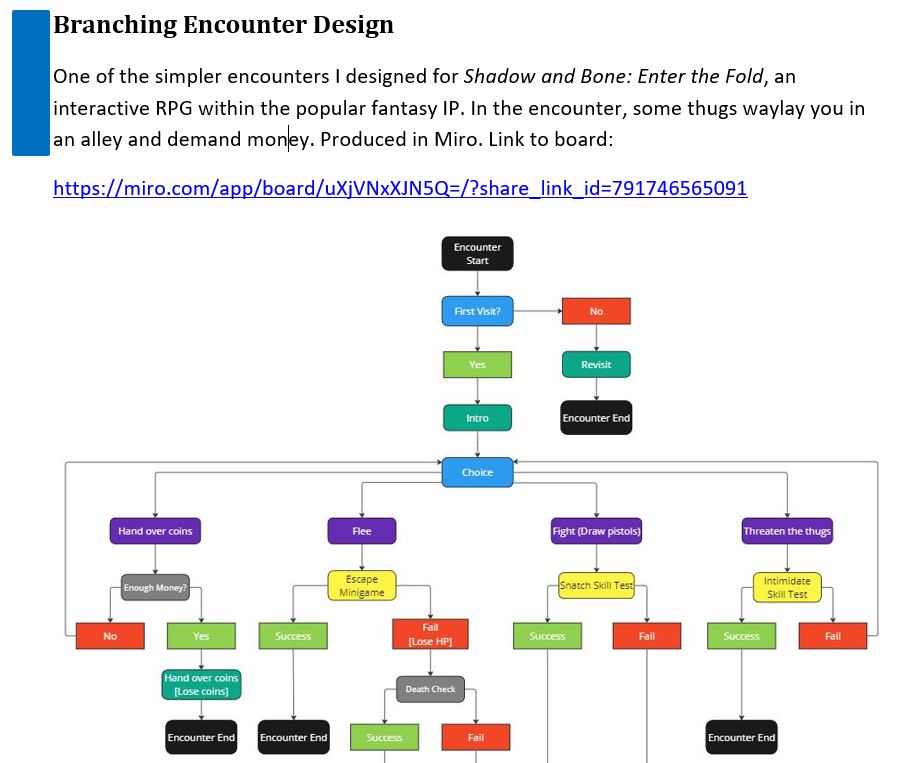If you’re applying for a video game writer or narrative designer position, chances are you’ll have to provide a portfolio. By this, I mean a collection of narrative samples to show off your skills. Here, I give my thoughts on how to make a good video game writing portfolio. Hopefully it’ll help you get to the next stage of your application for that dream job!
Making a Good Video Game Writing Portfolio
Making a good video game writing portfolio isn’t easy. If you’re just starting out, you probably won’t have much narrative content of your own ready to go. More established writers may have created the most scintillating stuff, but be unable to present it due to pesky NDAs. And then there’s the difficulty with knowing exactly what on earth the person reviewing the application wants to see.
To be clear, I’m not saying that I know of the way to approach a portfolio. But, I’ve had a modicum of success in applications I’ve submitted for the many projects I’ve worked on. I therefore wanted to share some tips that have worked for me. I hope they’re useful.
Read the requirements
It may seem obvious, but it’s so important to very carefully read the job advert to understand what the employer wants from you. If they ask for three samples, give them three samples. No more, no fewer. If it’s mentioned that the project features branching dialogue, try to include a branching dialogue sample.
Not explicitly addressing the requirements and being incapable of reading between the lines to understand what they’re really looking for is, unfortunately, just falling at the first huddle. Try to avoid it at all costs!
What Should be Included
Regardless of the position, there are a few things you’ll probably always want to include:
- Linear dialogues – Chances are, whichever role you’re applying for, it’ll involve writing or designing dialogues. You may wish to include some brief NPC exchanges, but I’d definitely recommend a dialogue exchange in screenplay format. This should be no more than 2 pages in length. We don’t always get the opportunity to write full-blown cinematic scenes outside the AAA space, but an intriguing conversation shows an understanding of dramatic structure and subtext.
- Branching dialogues – Unless you’re working on a choice-heavy RPG or a narrative adventure game, there’s not always as much call for extensively branching dialogues as some think. Nevertheless, it’s a good idea to show you have at least a basic understanding of writing tangible, distinct dialogue options. If the role is a narrative design one, you definitely want to include a branching sample.
- Item descriptions and lore entries – More prosaic writing, such as for item or character descriptions, is often a part of a video game writer’s job. It’s therefore worth including some text to show your prosaic flare. Just keep in mind that item descriptions should give you clear information on what the item is and does while ideally having some character, such as an element of humor or foreboding.
- Barks – AI will likely have an artificial hand in the creation of barks in the near future. Even so, showing that you can create variants of simple one-liners to contribute to worldbuilding and guide the player is still a valuable skill.
Just write something!
I’ve seen many emerging game writers paralyzed by the fact they can’t draw on samples from published games they’ve worked on. While providing samples from finished games is preferable, it’s not essential. Not being able to do so doesn’t mean you can’t show off anything. Look at how some of your favorite games approach dialogue interactions, item descriptions, and so on, and produce something of your own. If you’re not sure if it’s suitable for a portfolio, you can always ask for advice. Places like the Facebook Game Writers group or the Discord IGDA SIG Game Writing server.
Keep it brief
The video games industry is, to put it mildly, incredibly competitive. Narrative is one of the most competitive fields within it. The reality is that most job openings will receive dozens if not hundreds of applications. It’s imperative, therefore, that you keep your portfolio succinct and to the point while still covering all bases.
It’s not a hard and fast rule, but personally I aim to keep the entire portfolio no more than five pages long. Perhaps two pages will be devoted to your linear dialogue script, a page to your branching dialogue, a page to the descriptive text, and a page for barks. Resist the temptation to take the kitchen sink approach and chuck in 10+ pages of content. It likely just won’t be read and may even actively deter the inundated poor soul reviewing your application.
Tailor your portfolio
Ideally, tailor your portfolio to the role you’re applying for. If the job description mentions that you’ll be working on writing descriptive text, for example, throw in more item or quest descriptions. Crucially, if the position is for a narrative designer rather than a video game writer, make sure you include a sample that shows you know how to design a logical, satisfying narrative interaction. This could be a brief side quest with multiple potential approaches.

Although it’s time-consuming, if you can create different variants for different genres and tones of game, then even better. For example, if I know I’d be working on a more whimsical, child-friendly game, I won’t wheel out my dialogue sample peppered with swear words!
Provide context
Although not nearly as important as the samples themselves, I’ve found that giving some context can help anchor the reader.
Before each sample, detail the game which the sample is taken from, even if it’s one born from your imagination. You may also wish to specify the genre and tone of the game and what the sample represents. It doesn’t hurt to give the reader a gentle nudge to get them in the right frame of mind and calibrate their expectations as to what will follow.
Don’t get carried away, here, though. Keep it succinct. Try to focus on providing essential context for the scene rather than describing character traits, motivations and demeanours. These should shine through in the sample itself.
Check for typos
Again, this may seem obvious, but going through your video game portfolio with a fine tooth comb to check for typos and grammatical errors is extremely important. I’ve seen too many portfolios that are littered with mistakes. Frankly, it just comes across as amateurish, which is quite the opposite of what you’re trying to convey! It’s not always easy to spot them yourself, so ask a friend to have a look over for you.
It isn’t just that typos and grammatical mistakes undermine the assurance that you have a firm grasp of written language. Such carelessness also gives the impression that you won’t devote the diligence required to produce good quality work. After all, if you can’t do it for yourself without tight deadlines, how can you pledge to do it for others under great pressure when a milestone is looming?
Summary
These are just a few pointers that have served me well when creating my video game writing portfolio variants. To reiterate, perhaps the most important point of all is to make sure you carefully read the application requirements. Also, if the genre and tone of the game is stated, try to provide samples of a similar nature.
Keep your samples brief and varied. And don’t forget to check for typos and grammatical errors. This should give you the best chance of getting to the interview stage. Good luck!
